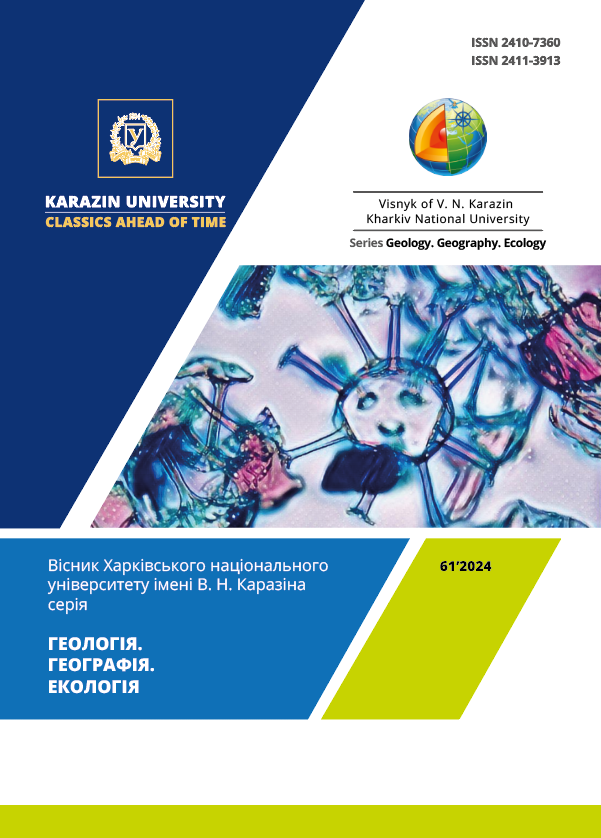Проблеми пошуків та діагностики карбонатитів на території України
Анотація
Достовірно установлені карбонатити на території України мають притаманні цьому класу порід характеристики, зокрема, вони збагачені досить широким спектром рідкісних хімічних елементів, найбільш характерні це рідкісноземельні елементи, стронцій, барій, ніобій, тантал, цирконій. Окрім того вони містять типоморфні мінерали такі як апатит, нефелін, лужні піроксени та амфіболи, тантало-ніобати, рідкісноземельні карбонати та ін. Достовірними ознаками карбонатитів є також особливі ізотопно-геохімічні дані, зокрема, ізотопний склад карбону, оксигену, стронцію. На першому місці серед вищезгаданих карбонатитів, за розміром та різноманітністю мінералізації, стоїть Чернігівський масив, карбонатити якого є типовими представниками цієї групи порід. Велика частина карбонатних порід, які мають окремі ознаки карбонатитів не можна відносити до цього класу, оскільки вони не відповідають вибраним критеріям і не містять слідів ендогенних джерел. Такими об’єктами можна вважати кальцифіри, мармури, скарни та апатит-вмісні породи Середнього Побужжя, (карбонатні асоціації Завалівсько графітового родовища, магнетитові кальцифіри Молдовського залізорудного родовища, карбонатні жили з хромітом Капітанівського родовища, Троянівський апатитовий прояв) флогопітові кальцифіри Верхнього Побужжя (Лукашівський прояв), а також численні метаморфічні карбонатні прояви Приазовського та Інгулецького мегаблоків (Мармурова ділянка Мангуського залізорудного родовища, карбонатні товщі Куксунгурського залізорудного родовища, кальцифіри Старокримської ділянки на периферії лужних масивів, Казанковський прояв та ін.) У цих породах визначено невисокі вмісти рідкісних елементів, відсутність типоморфних мінералів, а їх ізотопно-геохімічні характеристики, як правило, далекі від «карбонатитових». Перспективними районами Українського щита на пошуки карбонатитів можна вважати Приазовський, (продовження Хлібодарівської дайки, Південно-Кальчицький масив), Малотерсянський масив, та окремі прояви Волинського мегаблоку УЩ (структура Березова Гать). Потребують додаткових досліджень Анадольське та Азовське родовища рідкісних земель, де ще не виявлені карбонатні породи, але існують геохімічні та петрологічні передумови розвитку карбонатитів (існування потужних зон метасоматичних процесів лужного характеру, зокрема фенітизації, наявність високих концентрацій рідкісних елементів та акцесорних рідкісноземельних карбонатів, тощо).
Завантаження
Посилання
Voevodin V.N. (2006). On the classification of endogenous carbonate rocks. Otechestvennaya Geologiya, 6: 72-76.
Glevassky E.B., Kryvdik S.G. (1981). Precambrian carbonatite complex of the Azov region. Kiev, Naukova Dumka, 227.
Guliy V.N., Zahnitko V.N., Parfenova A.Ya. (1999). Comparative characteristics of carbonate-apatite associations of the Ukrainian and Aldan shields. Minerals – formation, forecast, resources, St.-Pt., June 5-8, 155.
Dubyna O.V., Kryvdik S.G., Vyshnevskyi O.A. (2024). Mineralogy and Petrology of Carbonatites and Phenites of the Khlebodarovsky Manifestation. Mineralogical journal, 46 (1): 45-66. https://doi.org/10.15407/mineraljournal.46.01.045
Entin V.A., Gintov O.B., Mychak S.V., Yushin A.A. (2015). Structure of the Moldovan iron ore deposit (Ukrainian shield) according to geological and geophysical data and its possible endogenous nature. 37, 4, 3-18.
Ershov V.A. (1960). Ultrabasic rocks of Ukraine and associated minerals. Petrographic provinces, igneous and metamorphic rocks. M., Publishing House of the Academy of Sciences of the USSR, 183-193.
Zhukov G.V., Varkhatov V.A., Sakhatsky I.I. (1973). On the discovery of phosphate mineralization in the Western Azov region. Geological journal, 33, 5: 144-146.
Zahnitko V.N., Lugovaya I.P. (1989). Isotope geochemistry of carbonate and ferruginous-siliceous rocks of the Ukrainian Shield. Kyiv: Naukova Dumka, 316.
Zahnitko V.M., Gogolev K.I. (2024). Non-standard models of transformation of iron ore formations in endo- and exogenous conditions. Materials of the conference "Iron ore deposits of Ukraine: modern problems and prospects for development". Kyiv, 41-45.
Carbonatites. Earth Sciences (1969). Ed. O. Tuttle, J. Gittins. M.: Mir., 486.
Kovalev E.M., Strekozov S.N., Zahnitko V.N., Lugovaya I.P. (1988). Carbonate Rocks of the Oktyabrskogo Alkaline Massif (Ukrainian Shield). Academy of Sciences of the USSR, ser. Geology, 7, 128-133.
Kolomiets G.D. (1987). New data on the protoplatform carbonatite magmatism of the Ukrainian shield. Theses of the reports of the IV regional petrographic conference on the European part of the USSR. Petrozav., 44.
Krivdik S.G., Tkachuk V.I. (1987). Formational belonging of alkaline metasomatites of Berezovoy Gati. B, 1, 13-16.
Kryvdyk S.G., Tkachuk V.I. (1990). Petrology of alkaline rocks of the Ukrainian Shield. Kyiv: Naukova Dumka, 407.
Kryvdik S.G., Dubyna O.V., Dovbush T.I. et al. (2011). Sr87/Sr86 in apatites from alkaline and basic rocks of the Ukrainian Shield. Mineralogical Journal, 33, 3, 55-70.
Lazurenko V.I., Ryabenko V.A., Khorunzhiy V.Y. (1977). Some varieties of fossil algae from Precambrian car-bonatenth rocks. Geological journal, 37, 2, 121-125.
Marchenko E.L., Konkov G.G., Vasenko V.I. (1980). On the carbonatite nature of the Petrovo-Gnutovskaya fluorite-carbonate dike of the Azov region. Reports of the Academy of Sciences of the Ukrainian SSR, ser. B, 1, 24-27.
Popovchenko S.E., Kornienko P.K. (2014). Qualification signs of carbonate-ultrabasite massifs of the Ukrainian shield. Bulletin of the Dnepropetrovsk University. Series "Geology. Geography", 15, 2-17.
Samoilov V.S. Kovalenko V.I. (1983). Complexes of alkaline rocks and carbonatites of Mongolia. The Works of the Soviets. Scientific research, 35. M. Nauka, 152-159.
Usenko O.V. (2022). Evolution of the composition of mantle fluids in the Precambrian (on the example of ferrugi-nous formations of the Ukrainian shield). Geophysical Journal, 2, 44, 3-28 https://doi.org/10.24028/gj.v44i2.256263
Tsarovsky I.D., Bratslavsky P.F. Nepheline breeds of the upper Pobuzhya. Doc. Academy of Sciences of the USSR, 1980, T 255, No. 2, pp. 424-427.
Tsarovsky I.D., Bratslavsky P.F. (1980). Nepheline breeds of the Dniester-Bug district. Kyiv: Naukova Dumka, 46 (preprint of the Academy of Sciences of the Ukrainian SSR, Institute of Geochemistry and Physics of Minerals).
Sheremet E.M., Kryvdik S.G., Strekozov S.M., Dubyna O.V., Setaya L.D. (2016). On the Genesis of the Anadol Rare Earth Deposit (Ukraine). Mineralogical Journal, 38 (4): 75-85 https://doi.org/10.15407/mineraljournal.38.04.075
Shramenko I.F., Stadnik V.A., Osadchiy V.K. (1992). Geochemistry of Carbonatites of the Ukrainian Shield. Kyiv: Naukova Dumka, 212.
Carbonatites. Genesis and Evolution (1990). Edited by Keith Bell. London. Unwin Hyman, 630.
Le Bas, M.J., Kellere, J., Kejie, T. et al. (1992). Carbonatite dykes at bayan Obo, inner Mongolia, China. Mineralo-gy and Petrology, 46, 195–228. https://doi.org/10.1007/BF01164647

Цю роботу ліцензовано за Міжнародня ліцензія Creative Commons Attribution 4.0.





